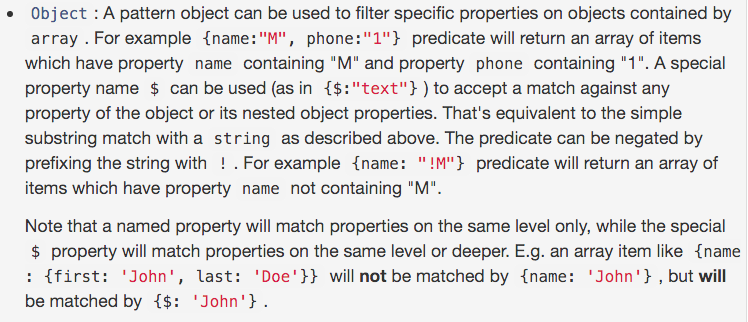1. filter可以接收参数,参数用 : 进行分割,如下:
{{ expression | filter:argument1:argument2:... }}
2. filter参数是 对象 ,匹配属性中含有value的
$scope.childrenArray = [ {name:'kimi',age:3}, {name:'cindy',age:4}, {name:'anglar',age:4}, {name:'shitou',age:6}, {name:'tiantian',age:5} ]; {{ childrenArray | filter : {name : 'i'} }} //参数是对象,匹配name属性中含有i的
示例:angular filter多个字段搜索
<input type="text" ng-model="search "> <!--<li ng-repeat="user in data.users | filter:{name:search}> --> <!--此时只搜索了name字段--> <!--搜索name字段、account字段--> <li ng-repeat="user in data.users | filter:{name:search}:{account:search}> <span ng-bind="user.name"></span> <span ng-bind="user.account"></span> </li>
3. 没有指定过滤哪个字段的情况下,默认filter会匹配所有字段(name、account)的值,类似 多个字段搜索
ng-repeat="user in data.users | filter:search
4. $ 匹配 对象 所有属性 和 嵌套对象属性
<li ng-repeat="user in data.users | filter:{$:search}>

5. bind ng-model to the “value” of selected item instead of item for ui-select
<ui-select ng-model="fm.countryCode" id="countryCode"> <ui-select-match placeholder="Select a country...">{{$select.selected.label}}</ui-select-match> <ui-select-choices repeat="item in countries | filter: $select.search" value="{{$select.selected.value}}"> <div ng-bind-html="item.label | highlight: $select.search"></div> <small ng-bind-html="item.value | highlight: $select.search"></small> </ui-select-choices> </ui-select>
Currently it's just setting fm.countryCode to the whole country item.
For example if I select Afghanistan, fm.countryCode will be set to {"value":"AF","label":"Afghanistan"}.
What I want is "AF".
so change the repeat part
<ui-select-choices repeat="item in countries | filter: $select.search" value="{{$select.selected.value}}">
to
<ui-select-choices repeat="item.value as item in countries | filter: $select.search" value="{{$select.selected.value}}">
示例:
<ui-select ng-model="networkDefaultValue.resourceId" name="networkname" theme="bootstrap" ng-change="setInputDefaultValue(['resource_id'],networkDefaultValue.resourceId,networkDefaultValue.isResourceIdInput)"> <ui-select-match allow-clear="true" placeholder="{{'Select an option'|translate}}">{{$select.selected.name + ' - ' + $select.selected.properties.datacentername}}</ui-select-match> <ui-select-choices repeat="resource.id as resource in totalNetworks | filter: { $ : $select.search}"> <div ng-bind-html="resource.name + ' - ' + resource.properties.datacentername | highlight: $select.search"></div> </ui-select-choices> </ui-select>
参考网址: